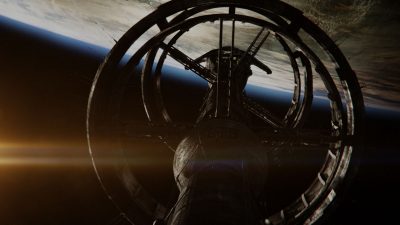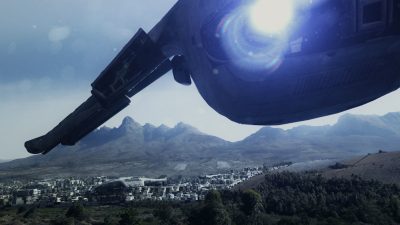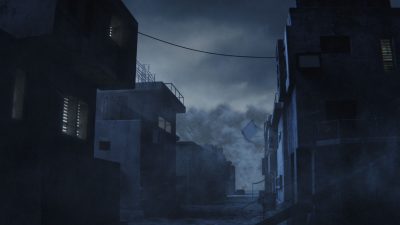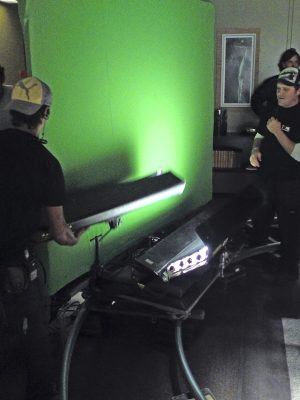Darkside Animation recently produced more than 300 visual effects shots for Outcasts, an eight part BBC series that aired earlier this year. In the show, a group of pioneers forge a new life on the fictional planet of Carpathia. We talk to Darkside’s Simon Percy and Andrew Bishop about creating spaceships and terrestrial effects for the series.
fxg: Let’s start with how Darkside got involved with Outcasts. How did that occur?
Andrew Bishop (Darkside’s Managing Director and animator): We had been working with the production company Kudos Television and Film for a while creating visual effects for shows such as Spooks and Hustle for the BBC. Our head of business development was passed a resurrected project to cast an eye over. We had several meetings and generated a couple proof of concept tests to show to the producers and in early January 2010 we were awarded all the VFX for the show.
fxg: Did you know early on that it would be the kind of show to have 300+ visual effects?
Simon Percy (Head of Studio): Well, it’s funny actually. One of the show’s writers, Ben Richards, said in a recent interview that ‘It’s not really a special effects show.’ I think right from the get-go, when we met the first director, he said he wanted to make sure that the visual effects weren’t prominent in the show and it was a real steer for us that they didn’t want the visual effects to be in your face – they would always be secondary. The film District 9 came up quite a lot – the effects were always superfluous, if you panned the camera around you’d just happen to see the spaceship or you’d see a creature. They’re incidental to the shots. So we had to keep in mind that these shots would not take over from the drama.
But as we started getting into these shows, the number of visual effects shots that were required in order to make them, kept creeping up. It ended up being just a smidgen over 300 effects shots that we did, plus another 100 shots by the post company doing the grade.
Bishop: Actually, originally it was mentioned to us that there’d be one space shot of the spaceship heading towards Carpathia, and of course by the end of the show, there are loads of shots!
Percy: In the last episode, the ship actually comes down onto the planet which was certainly never discussed until about three or four weeks towards the end of the show itself. So we had to re-jig the ship for atmospheric re-entry. We had to put flaps and slats and extendable wings and other bits and pieces so it looked like it was able to re-enter the atmosphere.
Break down of CT-10 in space in Episode 8fxg: In addition to the space scenes, there’s also so many other types of effects shots on the planet and it really has that Western feel – was that an interesting part of the production for you, having both styles of effects to deal with?
Percy: It was always part of the production that we would be augmenting the relatively small set that they built in South Africa. They built a main compound area plus several intertwining streets that they could shoot in and re-dress. Our VFX supe, Alan Marques, went out there in April 2010 with his wife who is a visual effects assistant and they looked after gathering all of the data that we needed on location for measuring the buildings and the props. I can’t tell you how many photographs we’ve got – ten and a half thousand if not more of reference material, plus many panoramic HDR probes of all the locations, some LIDAR scans and some map information. Out of that we were able to generate a three-dimensional version of the city of Forthaven.
 fxg: I understand the series was shot on the Arri D21 with anamorphic lenses. Can you talk about how this had any impact on your visual effects work?
fxg: I understand the series was shot on the Arri D21 with anamorphic lenses. Can you talk about how this had any impact on your visual effects work?
Bishop: The choice of working with anamorphic lenses was a decision made by the series premiere director Bharat Nalluri and the Director of Photography Adam Shuschitzky. The director loved the look of the flares in J.J. Abrams’ Star Trek and wanted to produce a similar look for Outcasts. The hope was that the BBC would support the transmission of a show shot in 2:4 format but sadly one week prior to principal photography they instructed the production to shoot 16:9 HD so the camera crew had to frame the action for this format.
For the visual effects work we had to work with the full scope image. We were shooting in Arri’s Mscope format onto Sony HDCAM SR decks lensing mainly with Hawk V series. These two streams were then re-combined back in London by the Farm and then delivered to Darkside as 2880×1080 DPX files. For things like 3D camera match moving we always had to work with the full 2:4 image so that the lens geometry was not damaged and the software would match move track without problems. The other main issue we had to contend with was the extreme levels of lens distortion that we had to correct for when working with the really wide lenses. Green screen keying was also more of a challenge as the Mscope format records into a 4:2:2 giving us less chrominance range to work with.
Percy: It started with the art department for the show at Kudos – they came up with a basic design that they threw over to us. It was quite ‘whalesque’, with a bulbous front bit and long arch section. The ships were always supposed to be something that could travel in space for a number of years from Earth over to Carpathia, then for the front portion to detach and then come into the atmosphere and land. We ended up building two iterations of the ship in Lightwave – the CT-9 which was at the front end, and then the CT-10, which is a variant and sleeker version with less windows – a military transport as opposed to a people transport.
 fxg: You mentioned that the outer space and transporter ship shots grew – how did you approach these sequences?The show wasn’t set too far into the future, only about 30 to 40 years, so we tried to make it look like something we could reference, like the International Space Station and the stuff that NASA is doing at the moment. There was lots of gantry work, not too much ‘nerding’ up of the models, but trying to keep it as realistic as we possibly could.
fxg: You mentioned that the outer space and transporter ship shots grew – how did you approach these sequences?The show wasn’t set too far into the future, only about 30 to 40 years, so we tried to make it look like something we could reference, like the International Space Station and the stuff that NASA is doing at the moment. There was lots of gantry work, not too much ‘nerding’ up of the models, but trying to keep it as realistic as we possibly could.
Bishop: When we did that opening shot of the ship flying over the camera, obviously you don’t have any sense of scale. The thing is meant to be huge, but you don’t really have a reference point other than panel detail, so we added in the back of the craft a ruddy great big window with people, and I have to say those people varied in size as we tried each shot out. We were trying to get them big enough that you could recognize people but small enough that could make you believe we could fit hundreds in.
Percy: Well, when we put some movement on them, to even notice the movement, they were running at maximum speed across the ship! It was just to try and keep the shot alive with those smaller details.
fxg: How was the planet created for the view-from-space shots?
Bishop: There are amazing star generators we used, some of them were NASA maps of the actual star field that we see every day.
Percy: For the planet, we ended up doing two versions in the end – we did a matte painting version which was expedient in the early days to get things out the door, but was obviously limiting in terms of movement. We needed to do lot of clouds forming in episode three for the whiteout seen from space. So we did a huge 8K matte paint of Carpathia at a couple of different angles, but then for that whiteout episode, we ended up using a very high res slice of the top half of the planet that we highly texture mapped and had multi-plane cloud layers to give us the motion of the clouds.
An example of Darkside’s city extension workfxg: Then on Carpathia, I imagine a lot of the work involved significant set extensions. How did you plan for those shots?
Percy: Well, essentially everything on Carpathia is built from cargo containers which were transported on the ships, so everything was based on a box. We came up with about 20 different set ups of the buildings with a whole selection of props – aerials, ventilation panels, power units, washing lines – that we could put on top of those sets and dress them. We then did a large top down image of the city so that we knew where the different sections were, and then we dressed the city up and essentially we would load those chunks in as and when required.
 fxg: What were the tools you were using for the city work, especially to add that gritty feeling to the images?
fxg: What were the tools you were using for the city work, especially to add that gritty feeling to the images?
Percy: We used Lightwave also, and then would apply loads and loads of dirt maps. When we thought it was dirty enough, the producer would ask us to weather it down even more. The city was meant to have been there for many years – it had to be battered and weathered. It needed to feel real, with the edges taken off the buildings.
Bishop: Caroline Phasey was our lead on that work and would paint every piece of detail and bump. There’s a shot where the character Fleur is hanging down from the roof and you can see there’s a sandy floor beneath her. Well that sandy floor was weeks of work to get that to look natural, with footprints in it and wind piling up the sand against the wall.
fxg: One of the significant sequences is the whiteout. Can you take me through that and the techniques you used?
Andrew: The dust was done by animating hypervoxels in Lightwave. The episode where it comes over CT-1 – all of those were hand-animated. They didn’t want it to look like a standard physics simulation. It had to do unusual things – for example it traveled backwards at one point. It’s supposed to be driven by the gravitational pull of the two moons.
A break down of a whiteout sequence from Episode 3I hand-animated the hypervoxels going over individual buildings and that gave it some dramatic impact. I could make it hit a building, then go vertical and it gave me the ability to sculpt it around CT-1. We added a debris layer over the top of that – the odd barrel and rubbish basically. There’s a shot of the dust storm coming down the valley too. What made that shot difficult was we couldn’t get the speed of both parts of the storm coming over the gap in the mountains and coming over the sides. We built some geometry for the mountains and two ‘waterfalls’ of the dust. That was done in three passes. It looks very simple but was probably the most difficult shot in the series! We composited that and most of the other work in Softimage’s Composite.
fxg: Let’s talk about some of the other VFX shots in the series – one of them is where President Tate meets another version of himself. How was that accomplished?

Percy: Alan Marques, when he was on set, knocked up a previs for that very quickly. This became a circular tracking shot, and with expensive motion control not being an option our VFX supervisor created the two passes of Liam Cunningham playing Tate by coming up with a manual approach utilizing the exceptional skills of the South Africa grips and camera crew to synchronize the two passes.
A circular track was set up with the camera dolly on one side and the green screen on the other. The green screen was then gripped around the track to keep it behind the body of the actor. Slight differences in the timing of the two passes was corrected using re-timing software.
fxg: How did you approach things like monitor inserts and graphic overlays for the show?
Percy: It was interesting, actually. For the sequence where CT-9 enters the atmosphere and is coming apart, where you have all the interactions between the captain of the ship and Tate, we actually worked on the monitor shots before the scene was shot. They asked us to do all the screen communications and degradations of those – it was about two minutes worth of footage that we had to pump out in about three days. They went for an old VHS style break-up rather than a digital break-up, which was more old-style. So we had to do a whole bunch of screen stressing and distortion. We were sent all the overlays by a company in South Africa and they arrived the next morning. Then they shot that day and then sent back in the rushes. So rather than us having to track and greenscreen and roto what was about 20 or 30 screens, they filmed it live, basically. We did do some monitor burn-ins later and actually they took some time to do.
fxg: And what were some of the additional kinds of shots you worked on?
Bishop: We had things like the virus, animating little horsefly-like creatures, throwing weapons off cliffs, and then a whole bunch of compositing work as well.
Break down of virus effects for Episode 8fxg: Finally, what was your crew size and production time for the show?
Percy: It was never a clear-cut case of having a set time on each episode as there were editorial changes happening throughout the production but on average we had about a three week window on each show. The early shows that were setting the look and feel of the key assets both in space and on Carpathia took longer, coming in at about five weeks. The entire production cycle was from April 2010 when Alan went out to supervise the shoot in South Africa, through VFX pre-production and prep in June and July to full post production in September and final shot delivery in early February 2011.
